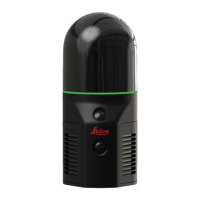a Detail camera
b Panoramic camera
5.3 Scanning
5.3.1 Ambient Conditions
•
Highly reective (polished metal, gloss paint)
•
Highly absorbent (black)
•
Translucent (clear glass)
☞
Color, powder or tape these surfaces before scanning if necessary.
•
Rain, snow or fog may adversely affect measurement quality. Always use
care when scanning in these conditions.
•
Surfaces that are directly illuminated by the sun cause an increased range
noise and therefore a larger measurement uncertainty.
•
If some objects are scanned against the sunlight or a bright spotlight, the
optical receiver of the instrument can be dazzled so heavily that in this
area no measured data is recorded.
If the instrument is brought from a cold environment, for example from stor-
age, into a warm and humid environment, the mirror or in extreme cases even
the interior optics can condense. This may cause measurement errors.
☞
Precaution: Avoid rapid temperature changes and give the instrument
time to acclimatize.
Due to the encapsulated mirror design, the mirror is protected against direct
contact. But dirt on the dome such as a layer of dust, condensation or nger-
prints may cause considerable measuring errors.
5.3.2 Troubleshooting
Problem
Possible cause Suggested remedies
Missing points in
scan.
Dust, debris or nger-
prints on the dome.
Use a glass cleaning tis-
sue to clean the specic
areas.
Camera position
Unfavorable surfaces
for scanning
Unfavorable weather
conditions for scan-
ning
Temperature changes
during scanning
Dirt on the dome
Basic troubleshooting
Operation 23

